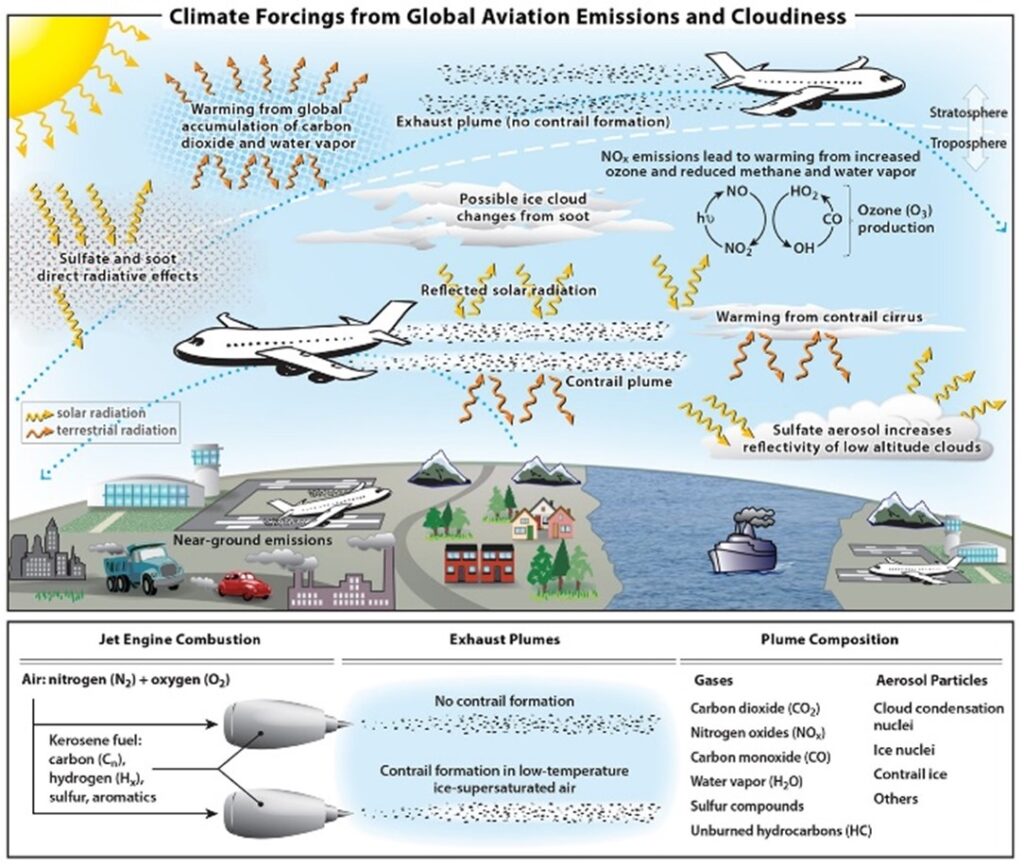Contrail avoidance and its role in aviation climate impact mitigation

Project Overview
This project will use state-of-the-art weather and climate models to evaluate the climate impact of contrail avoidance for current and future generation aircraft.
Background and context
The aviation industry is under increasing pressure to reduce its climate footprint, with ambitious national and international targets. For instance, the UK’s Sixth Carbon Budget (2021) aims to reduce national emissions, including those from international aviation and shipping, by 78% by 2035 (UK Government, 2021). Similarly, the International Air Transport Association (IATA) has committed to achieving net-zero carbon emissions globally by 2050 (IATA, 2021).
While CO₂ emissions are a major focus, non-CO₂ effects, such as contrail cirrus, are estimated to account for approximately 66% of aviation’s effective radiative forcing (ERF) (Lee et al., 2021). Mitigation strategies in proposed net-zero pathways include the adoption of alternative fuels (e.g. sustainable aviation fuel and hydrogen) and targeted approaches to reduce non-CO₂ impacts (Rap et al., 2021; Dray et al., 2022), including through contrail avoidance (Mannstein 2005; Teoh et al. 2020).
Contrail avoidance involves rerouting aircraft to minimize the formation of persistent contrails, the thin, line-shaped clouds formed under ice-supersaturated conditions due to the mixing of aircraft exhaust with ambient air (Karcher, 2018). These contrails can evolve into contrail cirrus, which contribute significantly to aviation-induced warming. Contrail avoidance relies on integrating real-time weather data into flight planning in order to avoid the ice supersaturated regions (ISSRs) where contrails are likely to form and persist.
A recent meta-analysis of contrail avoidance modelling studies suggested that half of the contrail length could be avoided at a penalty of 1% increase in fuel burn (Dray et al., 2022). Trials in Europe (Sausen et al., 2024) and the US (Google, 2024) have shown promising results, including a 54% reduction in contrail coverage using AI-based predictions, albeit with fuel penalties of 1–2%. However, challenges remain, particularly in the accuracy of weather models to forecast ice-supersaturated regions (ISSRs) (Sausen et al., 2024; Hofer et al., 2024) and the trade-offs associated with rerouting.

Project objectives:
The primary aim of this project is to quantify the climate impact of contrail avoidance strategies for current and future aircraft fleets. The modelling approach will involve the use and development of the state-of-the-art UK Met Office Unified Model (UM), including its recent contrail cirrus parameterisations and weather forecast models. While relatively flexible to allow for your interests, specific objectives may include:
- Evaluating model performance: Assess the skill of the UM in forecasting ice supersaturated regions (ISSRs) using in-situ observations (e.g. IAGOS) and reanalysis datasets;
- Quantifying contrail cirrus ERF reduction: Estimate the reduction in ERF from contrail cirrus under various contrail avoidance strategies;
- Assessing total aviation ERF: Determine the net climate impact of contrail avoidance, accounting for both reduced contrail formation and increased emissions from rerouting;
- Exploring climate metrics: Investigate the role of different climate metrics in setting aviation mitigation targets.
Potential for high impact outcome
This project addresses key uncertainties in aviation’s climate impact and will inform future mitigation strategies. The findings will be relevant to policymakers, industry stakeholders, and the broader climate science community. Results are expected to be published in high-impact journals and presented at international conferences.
Training
The student will work under the supervision of Dr Alex Rap and Prof Piers Forster and will be a member of the Physical Climate Change research group in SEE. The project provides an exciting opportunity to be trained in and exploit the new UK Earth System Model (UKESM) via collaborations with UK Met Office staff. The student will also be part of the Priestley International Centre for Climate that brings together world leading expertise in all the key strands of climate change research at the University of Leeds.
Training will include:
- Hands-on experience with the UK Met Office Unified Model (UM) and collaborations with UK Met Office scientists.
- Advanced scientific training in climate modelling and aviation impacts.
- Development of communication skills and publication strategies for high-impact research.
In addition, the Faculty offers a wide range of workshops—from numerical modelling to thesis preparation and viva readiness. A full list of training opportunities is available here.
Eligibility requirements
A good first degree, Masters degree or equivalent in a quantitative science discipline (e.g. Physics, Mathematics, Chemistry, Atmospheric Science, Engineering) and a keen interest in global environmental problems. While a substantial part of this project involves computer modelling, prior experience is not essential – we provide high level specialist scientific training during the PhD.
References
- Dray et al., 2022. Cost and Emissions Pathways towards Net-zero climate impacts in aviation. Nature Climate Change 12(10), 956-962.
- Google, 2024. Project Contrails. [Online]. Available from: https://sites.research.google/contrails/
- Hirst, 2021. Aviation, decarbonisation and climate change. House of Commons Library Research Briefing, 8826, 20 September 2021.
- Hofer et al., 2024. How well can persistent contrails be predicted? An update, Atmos. Chem. Phys., 24, 7911–7925.
- IATA, 2021. Net-Zero Carbon Emissions by 2050, International Air Transport Association, Press release No 66, 4 October 2021.
- Karcher, 2018. Formation and radiative forcing of contrail cirrus, Nature Comm., 9, 1824.
- Lee et al., 2021. The contribution of global aviation to anthropogenic climate forcing for 2000 to 2018, Atmospheric Environment, 244, 117834.
- Mannstein et al., 2005. A note on how to avoid contrail cirrus. Transportation Research Part D: Transport and Environment, 10(5), 421-426.
- Rap et al., 2021, The impact of contrails and NOx emissions for FlyZero aircraft concepts with alternative fuel and energy systems, Fly Zero Report FZ_RB_001, ATI.
- Sausen et al., 2024. Can we successfully avoid persistent contrails by small altitude adjustments of flights in the real world?, Meteorol. Z., 33(1), 83-98.
- Teoh et al., 2020. Beyond Contrail Avoidance: Efficacy of Flight Altitude Changes to Minimise Contrail Climate Forcing, Aerospace, 7(9), 121.
- UK Government, 2021. UK enshrines new target in law to slash emissions by 78% by 2035. Press release, 20 April 2021.
